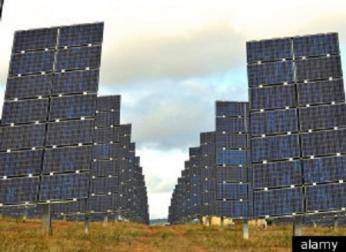
By MATTHEW DALY
WASHINGTON — The Obama administration on Thursday identified 17 sites in six Western states as prime candidates for solar energy projects on public lands, continuing a push for solar power despite the high-profile bankruptcy of a solar panel maker that received a half-billion dollar federal loan.
Interior Secretary Ken Salazar said the latest "Solar En ergy Zones" refine and improve on a draft released in December that identified two dozen areas in California, Nevada, Colorado, Utah, New Mexico and Arizona.
Five sites in Nevada, four in Colorado, three in Utah, two each in California and Arizona, and one in New Mexico were identified as ideal for solar development.
The sites comprise 285,000 acres, down from about 677,000 acres in December, and reflect the department''s judgment that the targeted land has the highest potential for solar development with the fewest environmental conflicts.
The plan is intended to promote development of large, utility-scale solar projects on public lands that will generate thousands of megawatts of electricity. The zones are intended to maximize electricity generation while minimizing conflicts with wildlife and cultural and historic resources.
Salazar called the announcement a "giant step forward" as officials step up efforts to promote solar power, particularly in the West.
The administration''s push for renewable energy has come under attack since California-based Solyndra Inc. closed its doors two month ago after receiving a $528 million federal loan. The company declared bankruptcy and laid off its 1,100 workers.
The new plan, which is subject to a 90-day public comment period, "establishes for the first time a blueprint for landscape-level planning that will help facilitate smarter siting of solar energy projects," Salazar said in a conference call with reporters.
It also proposes to open an additional 20 million acres of public land to future solar development.
Environmental groups hailed the announcement, but the solar industry was guarded in its response. Rhone Resch, president and CEO of the Solar Energy Industries Association, said he had "some significant areas of concern" about the solar energy zones
Flexibility in project siting and access to transmission were crucial to financing and development of utility-scale solar power plants, Resch said, adding that he was optimistic a balanced approach could be found.
The Bureau of Land Management has done "a commendable job permitting solar power projects over the last two years," he said. "We look forward to engaging with BLM and other stakeholders in this process to continue that momentum and ensure the industry''s perspective is heard."
While California has only two projects – both near the Arizona border in the southeastern corner of the state – it has more than half the total acreage, with 153,627 acres. Nevada has the next-highest acreage at 60,395.
Salazar and other officials said the plan aims to reduce conflicts and delays in approving solar projects, by identifying areas that have been "pre-screened" to show they are near transmission sites and have few if any environmental conflicts.
Deputy Interior Secretary David Hayes said the new plan "provides more clarity" on how projects can proceed and gives potential developers certainty that they will be working in areas that the government considers suited for solar power.
The new plan is based in part on more than 80,000 comments received after the draft plan was announced in December. The seven sites that were dropped from the draft plan include two each in California, Nevada and New Mexico, and one in Arizona.
None of the seven sites had attracted significant interest from investors and either had looming environmental conflicts or were far away from transmission lines, Hayes said, adding that he is confident the remaining 17 projects will be attractive to utilities and other developers.
The department has 79 applications for solar projects on public lands pending and expects to approve as many as 14 next year, officials said.
Four public meetings on the plan are scheduled in November and December.
Article courtesy of huffingtonpost.com

